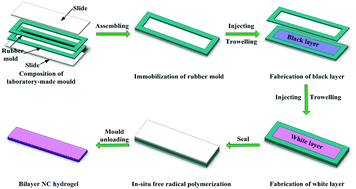Design and fabrication of nanofibrillated cellulose-containing bilayer hydrogel actuators with temperature and near infrared laser responses†
Abstract
A novel type of nanofibrillated cellulose (NFC)-containing poly N-isopropylacrylamide-clay bilayer nanocomposite hydrogel actuator was successfully fabricated via one-step in situ free radical polymerization. The bilayer hydrogel exhibited rapid, reversible and efficient temperature and near infrared laser responses in air and water. With an increase in the NFC content, the cross-density of hydrogels enhanced, leading to an increase in the strength and deswelling rate and a decrease in the strain, swelling rate and bending degree. The two layers in the bilayer structure bonded tightly. The bilayer hydrogel dimensions affected the deformation ability. The smaller the bilayer hydrogel, the higher the bending degree exhibited by the actuators. Bending degree in poikilothermy temperature ranging from 32 to 50 °C was higher than that in the constant temperature of 50 °C. Based on the intelligent responsive property, the bilayer hydrogel was designed as a soft temperature-controlled manipulator, which can be treated as a candidate material for medicine and soft robotics.



 Please wait while we load your content...
Please wait while we load your content...